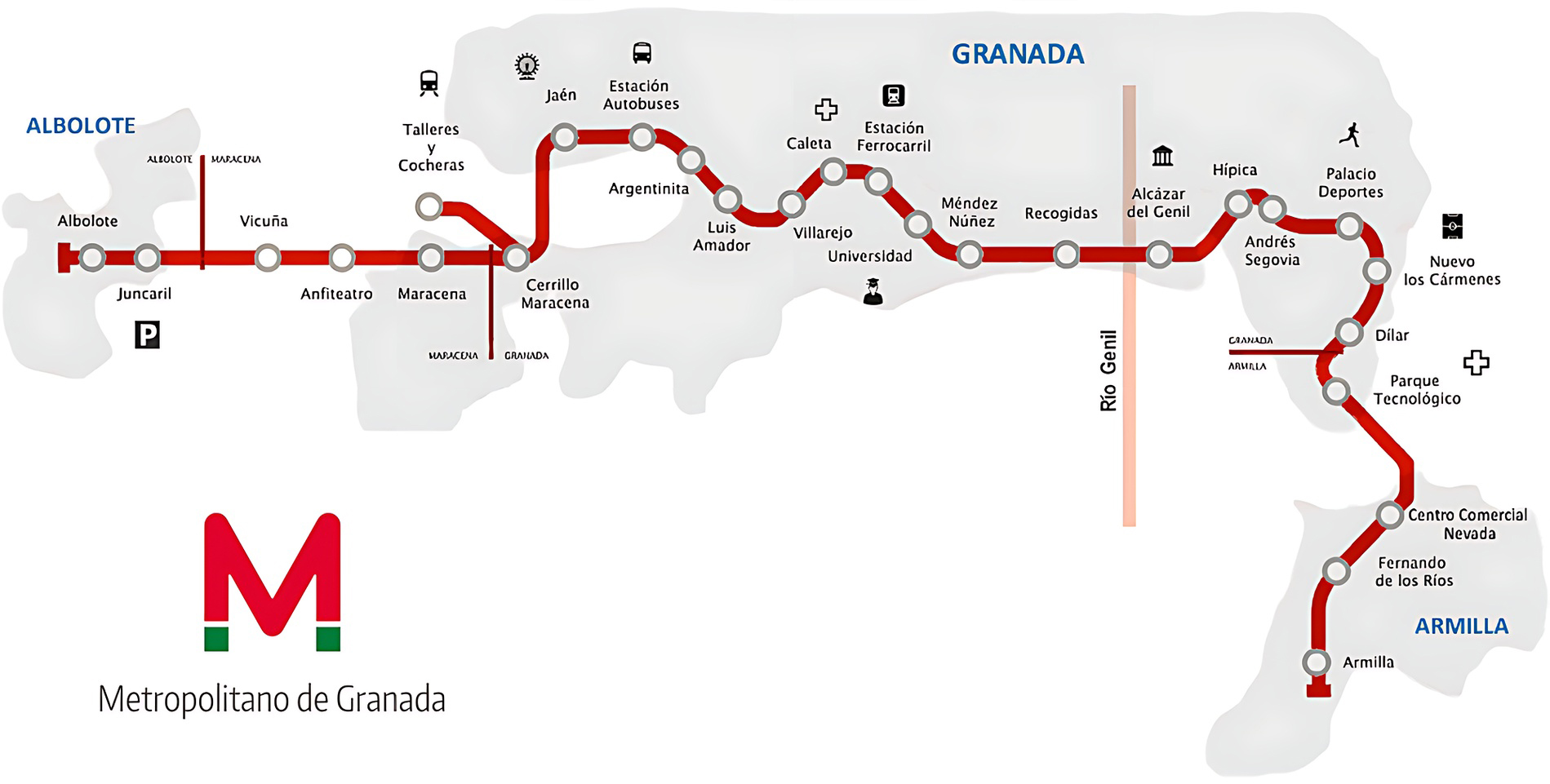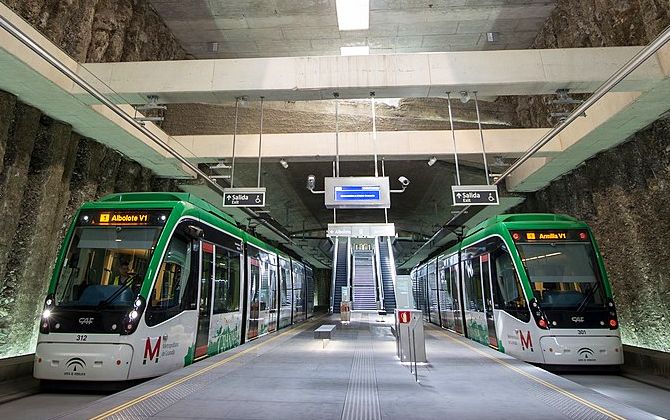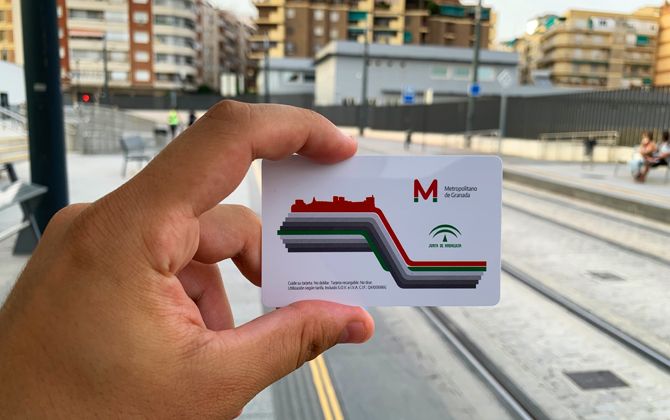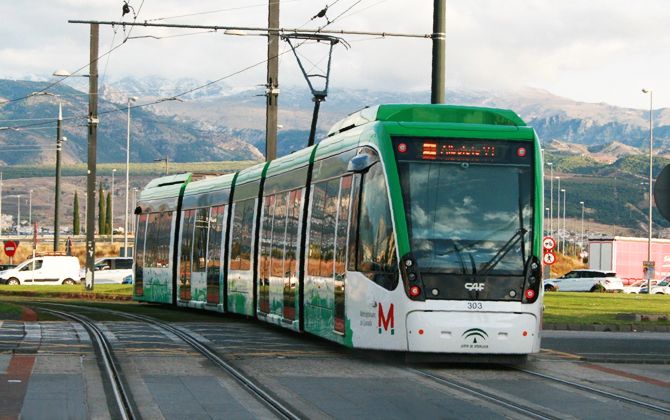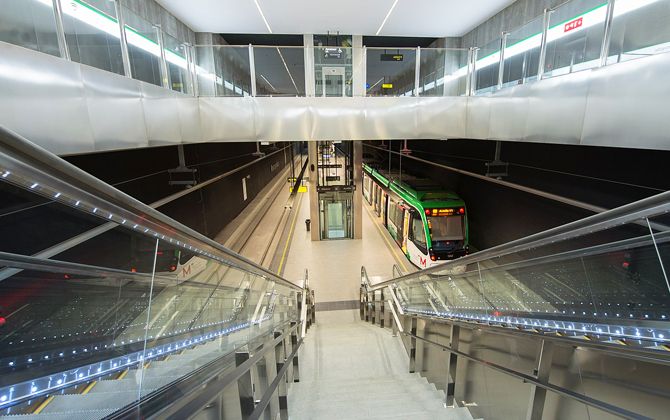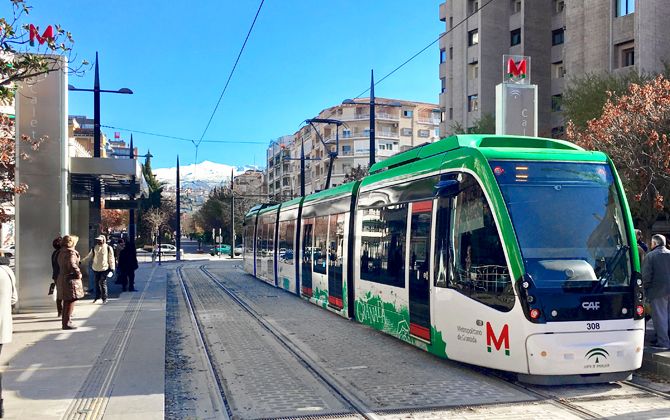The Granada Metro (Metro de Granada) is a light-rail system with one line that serves Granada and nearby suburbs. It runs north–south from Albolote to Armilla over 15.9 km (9.9 mi) and has 26 stations. The system opened on 21 September 2017 and carries around 35,000 passengers on weekdays, or about 14.1 million riders in 2023. The Metro is owned by the regional government of Andalusia. It operates 15 CAF Urbos trams, each with 5 carriages and space for about 200 passengers.
Granada is a medium-sized city in Spain with a population of about 233,500 (2024). It is best known for the Alhambra palace and its Moorish heritage. The Metro was designed to improve travel across the metropolitan area and reduce car use. Construction started in 2007 but was slowed by financial delays after the 2008 economic crisis. Funding was later secured through Spanish and EU sources, including a €260 million (≈$276 million) loan from the European Investment Bank in 2014. Line 1 finally opened in September 2017. Since then, passenger numbers have steadily grown, showing strong demand for the service.
Metro Map of Granada
The Granada Metro consists of a single line (Line 1) running from Albolote in the north through Maracena and Granada city to Armilla in the south. The line is 15.9 km (9.9 mi) long and has 26 stations. Three stations in central Granada are underground; the rest are at ground level. The official system map shows this north–south route. Key interchange stations include Estación de Autobuses (Bus Station), Estación de Trenes (Train Station), Universidad, Recogidas (Gran Vía area), and Parque Tecnológico (Health and Technology Park).
Map of Granada Metro showing different lines. Click on the map to enlarge it or download the Granada Metro map in PDF format.
Lines and Stations
The Granada Metro has one line (Line 1) with 26 stations. Below is the full list with short descriptions:
- Albolote – Northern terminal in the town of Albolote, about 7 km (4.3 mi) north of Granada. Surface-level station serving the local urban area. Bus links include interurban line 122 to Atarfe. Park-and-ride bicycle parking available.
- Polígono Juncaril – Located in the Juncaril industrial zone of Albolote.
- Vicuña – Surface stop in Maracena municipality, serving suburban residential areas.
- Anfiteatro – In Maracena, named after a nearby amphitheater.
- Maracena – Central station in the town of Maracena.
- Cerrillo Maracena – On the outskirts of Maracena (Cerrillo area).
- Carretera de Jaén – On the Albolote–Granada highway toward Jaén. Suburban stop.
- Estación de Autobuses (Bus Station) – Major hub at Granada’s intercity bus terminal. Connects with almost all city and regional buses, including lines to the coast and inland towns.
- Argentinita – Serves the Argentinita neighborhood of Granada.
- Luis Amador – Named after Calle Luis Amador. Near local shops and schools.
- Villarejo – Serves a small residential neighborhood.
- La Caleta – Stop for the La Caleta residential area.
- Estación de Trenes (Train Station) – At Granada’s main railway station. Offers national and regional trains, including AVE high-speed services to Madrid and Barcelona. Local bus links available.
- Universidad – Located at the University of Granada campus. Convenient for students and near university parks.
- Méndez Núñez – Named for a central street. Serves an urban area with shops and services.
- Recogidas – On Calle Recogidas in central Granada, near the Cathedral and historic quarter. Good for shopping and sightseeing.
- Alcázar del Genil – Underground station near the medieval Alcázar Genil palace and riverside park. Features ancient reservoir remains integrated into the station design.
- Hípica – Surface station in the Hípica district, close to the military riding school.
- Andrés Segovia – Named after the guitarist. Near sports fields and schools.
- Palacio de Deportes – Next to Granada’s indoor sports arena and Parque de las Ciencias (Science Park).
- Estadio Los Cármenes – Beside the Los Cármenes football stadium, home of Granada CF.
- Dílar – Surface stop on the old Dílar road, southern approach to Granada.
- Parque Tecnológico – Serves the Granada Health Technology Park (PTS), a medical and research campus, and new residential areas.
- Nevada (Centro Comercial Nevada) – By the Nevada shopping mall, a large retail center on the city’s edge.
- Fernando de los Ríos – In Armilla, on Avenida Fernando de los Ríos. Near shops and local parks.
- Armilla – Southern terminal in Armilla, 1 km (0.6 mi) south of central Granada. Located on Av. de Poniente near the town hall square. Connected by bus line 156 to Churriana de la Vega and Las Gabias.
Schedule, Timetables, and Calendar
The Granada Metro runs daily from 06:30 to 23:00 on Mondays to Thursdays, Sundays, and public holidays. On Fridays, Saturdays, and holiday eves, service continues until 02:00 with late-night trains. First trains leave both terminals (Albolote and Armilla) at 06:30. The last departures are around 23:00, or 02:00 on weekends and holiday eves. Passengers boarding mid-line should allow for travel time.
Train frequency depends on time and day:
- Weekday peak hours (07:30–10:00 and 13:30–21:30): every 8 minutes.
- Weekday off-peak: every 10–15 minutes.
- Late-night Fridays and Saturdays (after 21:30): every 15–30 minutes.
- Weekends: every 10–22 minutes, depending on the time of day.
Special timetables apply during major events. For example, during Holy Week (Semana Santa), service is extended. In 2026, the Metro ran until 24:00 on Wednesday and Thursday, and from 06:30 to 02:00 on other days. Passengers should always confirm the current schedule at stations.
Tickets, Prices, and Fares
Metro tickets are available as paper tickets or reloadable cards. Fares are flat rate with no zones. Children under 4 travel free. Seniors and other groups do not receive special discounts. Main fare options:
| Ticket Type | Price (EUR) | Price (USD) |
|---|---|---|
| Single journey (Univiaje) | €1.35 | ≈$1.50 |
| Round trip | €2.70 | ≈$3.00 |
| Tourist 1-day card | €4.50 | ≈$5.00 |
| Monthly pass (30-day) | €20.00 | ≈$22.00 |
Notes:
- A Monedero stored-value card can lower the fare to about €0.41 (≈$0.45) per trip when recharged with the minimum amount, under current discount schemes.
- The 1-day tourist card gives unlimited rides on both Metro and city buses for 24 hours.
- The 30-day pass allows unlimited Metro travel for a month. No student or senior discounts apply.
Ticket machines at all stations accept cash (coins and bills) and usually provide instructions in several languages. At above-ground stops, tickets must be validated on board the tram. At underground stations, validation is required at entry gates.
Investments in Public Transportation
Granada’s transit system is undergoing major investment. A southern metro extension from Armilla to Churriana de la Vega and Las Gabias is under construction. This 4.6 km (2.9 mi) branch with 7 new stations has a budget of €87.36 million (≈$95 million), more than 80% co-financed by EU NextGeneration funds. Work began in late 2023 and is divided into phases. The first section, from Armilla to Churriana (2.7 km / 1.7 mi with 4 stops), is expected to be completed by 2026. In addition, 8 new metro trains were purchased for €40 million (≈$43 million), partly with EU funding, to increase capacity.
Beyond the Metro, Granada has expanded both city and intercity bus fleets with low-emission vehicles and improved park-and-ride facilities. Several suburban bus routes were rerouted to connect directly with the Metro, for example near Avenida Carlos V. Public transit investment remains a priority for Andalusian and EU authorities, aiming to reduce car traffic and emissions across the metropolitan area.
Connections
All metro stations connect with Granada’s bus network. Local Rober buses and intercity Consorcio buses serve the stops. Key interchanges include:
- Albolote (Terminus): Interurban Bus 122 to Atarfe and Sierra Elvira.
- Armilla (Terminus): Interurban Bus 156 to Churriana de la Vega and Las Gabias.
- Estación de Autobuses (Bus Station): Major hub for city and regional buses, including routes to Almuñécar, the Costa, and Monachil.
- Estación de Trenes (Train Station): Linked with city buses such as line 33.
- Recogidas: Served by city bus lines 3, N3 (to Alhambra and the old town), and others along Gran Vía.
- Nevada (Shopping Mall): Connected to suburban buses serving outer districts and the city.
Metro and bus transfers use the same Consorcio Verde card. A standard bus–metro transfer costs about €0.66 (≈$0.72). Passengers should always check local timetables and maps, as routes may change.
Connection to the Airport
Granada’s Federico García Lorca Airport lies 17 km (10.5 mi) east of the city. The Metro does not serve the airport directly. Instead, a shuttle bus operated by ALSA runs between the airport and the city center. Stops include Avenida de Andalucía, the Bus Station, Gran Vía de Colón, and Paseo del Violón near the Palacio de Congresos. Metro users can transfer to this line at the Bus Station or other central stops.
The airport bus takes about 45 minutes. A ticket costs around €3–4 (≈$3.25–$4.35). Plans for a future Metro Line 2 to the airport exist but remain under discussion.
Granada: A Small City with a Rich Heritage
Granada is a compact city with a rich history. Located at the foot of the Sierra Nevada mountains, it has about 233,500 residents (2024). The Alhambra, a medieval Nasrid palace and fortress, is the city’s crown jewel. Along with the Albaicín neighborhood, it is a UNESCO World Heritage site. Granada was the last Moorish kingdom in Spain, conquered in 1492, and still preserves much Islamic-Moorish architecture.
Although the Metro does not enter the hilly historic core, it provides easy access. From Recogidas station, the Cathedral and old town are just a short walk away. Universidad and Recogidas stations are also close to shopping streets and nightlife areas. Granada is home to about 47,000 university students, so the Metro often carries many young passengers. Other attractions, such as the cable car to the Sierra Nevada ski resort or flamenco shows in the Sacromonte caves, are reached by bus from central stops. With a compact area of just 34 km² (13 mi²), Granada is walkable, but the Metro and buses are useful for reaching suburbs and longer distances.
Tips and Rules
- Ticket Validation: Always validate your ticket or travel card. In underground stations, use the entry gates. At surface stops, validate inside the train using the onboard machine.
- Boarding: Trains have multiple doors, and passengers may enter through any. Double-door sections are reserved for wheelchairs and prams. All stations have ramps for step-free access. Priority seats are for elderly, disabled, and pregnant passengers.
- Bicycles: Up to 2 bicycles are allowed per train if space is available. Foldable bikes and scooters are permitted. Riders should stand near the doors or designated areas.
- Pets: Small pets in carriers are allowed. Service and guide dogs travel free with their owners.
- Luggage & Behavior: Keep luggage clear of aisles. Smoking, eating, and drinking are not allowed. Use headphones for music and keep noise down. Watch for pickpockets during busy times.
- Stations: Trains stop for about 20 seconds at each station. Do not lean on doors or attempt to board or exit after the doors begin closing.
History
The idea for a metro in Granada dates back to the late 1990s. Actual construction began in 2007. The line was first expected to open in 2012, but the global financial crisis caused delays. In 2014, the Andalusian government secured a €260 million (≈$283 million) loan from the European Investment Bank to finish the project. The first section opened on 21 September 2017.
After launch, the system was upgraded with more ticket machines, better signage, and four additional trams to reduce overcrowding. Timetables were adjusted to improve reliability. Despite early doubts, the Metro quickly became crowded during peak hours, sparking demand for extensions. Meanwhile, city buses and bike services were reorganized to integrate with the Metro, with many suburban buses now terminating at Metro stations instead of duplicating routes.
Fun Facts
- Alcázar Genil Station: Built around the ruins of a 13th-century Almohad reservoir. The underground stop feels like a small museum inside the Metro.
- Short & Compact: At 15.9 km (9.9 mi), Granada Metro is one of Spain’s smallest metro systems. Despite this, it has 26 stations and carries over 14 million riders per year.
- End-to-End Trip: Traveling from Albolote to Armilla takes about 47 minutes, with an average speed of 20 km/h (12.4 mph) including stops.
- Mostly Surface-Level: 83% of the line is at ground level. Only three stations are underground, while most trains run at street level alongside cars.
- Fast Service: During weekday peaks, trains arrive every 8 minutes—faster than many surface bus lines.
- Accessibility: All stations and trains are wheelchair-friendly. Elevators and ramps connect platforms for step-free access.
- No Fare Zones: The fare is flat. Passengers pay the same price whether traveling one stop or the full line.
- Free for Children: Up to two children under 4 years old ride free with a paying adult.
- High Ridership: By 2023, weekday ridership exceeded 44,000 passengers, surpassing forecasts and showing the Metro’s popularity.
Future Expansions
Granada Metro expansion plans are underway. The Southern Extension will continue beyond Armilla through Churriana de la Vega to Las Gabias. The full branch will add 4.6 km (2.9 mi) and 7 new stations. Construction of the first section from Armilla to Churriana has already started, with later phases reaching Las Gabias. Completion is expected in the mid-2020s, funded partly by EU COVID-recovery (NextGeneration) funds.
On the northern end, a North Extension from Albolote to Atarfe is in the planning stage. Two route options have been studied. The longer option would add 4.9 km (3 mi) and six stations. The Andalusian government has requested about €144 million (≈$156 million) in European funds, tied to a parallel highway project. As of 2026, design and early preparation work is ongoing. If approved, this extension would take the Metro into the province’s agricultural lowlands.
New lines are also being discussed. A proposed Line 2 could run from central Granada east toward the airport, to Ogíjares, or north to Peligros. Other ideas include branches from the existing terminals, such as Armilla to Cúllar Vega or Alhendín, and Albolote to Atarfe or Santa Fe. These projects remain conceptual and depend on future funding. For now, the main priority is completing the southern extension.
Nearby Attractions
- Centro (Historic Core): From Recogidas station, the Cathedral and Royal Chapel are about 500 m (0.3 mi) away. The Albaicín and Alhambra are a 10–20 minute walk uphill via Plaza Nueva or can be reached by city bus.
- Universities: Universidad station serves the University campus and botanical gardens.
- Science & Sports: Palacio de Deportes and Los Cármenes stations are next to the Science Park (Parque de las Ciencias) and Granada’s main football stadium.
- Shopping & Leisure: Nevada station is located at the entrance of the Nevada Shopping Centre with cinemas, shops, and restaurants.
- Cultural Sites: Alcázar del Genil station is near the medieval Alcázar palace, now a museum, and a riverside park.
- Beaches & Nature: The Metro does not connect directly to beaches. Bus #143 from the Bus Station goes to the Costa Tropical (Almuñécar region). The Sierra Nevada ski resort is about 30 km (19 mi) away by car.
Overall, the Metro is ideal for quick travel across flat urban areas and outlying suburbs. Tourists usually rely on buses or taxis to reach the Albaicín, Sacromonte caves, and the Alhambra, since these are not served directly by the Metro. Visitors can use the Metro to avoid city traffic, then switch to buses or walk from central stations to historic sites.
